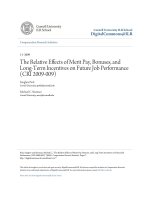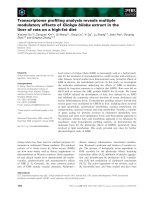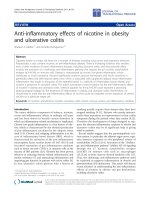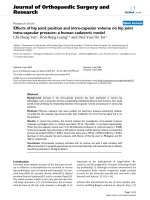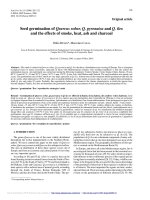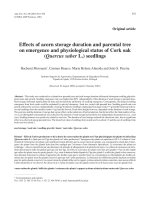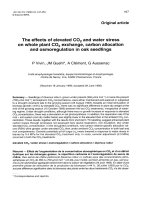Effects of grape seed extract and calorie restriction on aging process
Bạn đang xem bản rút gọn của tài liệu. Xem và tải ngay bản đầy đủ của tài liệu tại đây (1.74 MB, 184 trang )
1
EFFECTS OF GRAPE SEED EXTRACT AND CALORIE RESTRICTION
ON AGING PROCESS
CHEN JIE
(Master of Medicine)
A THESIS SUBMITTED
FOR THE DEGREE OF DOCTOR OF PHILOSOPHY
DEPARTMENT OF OTOLARYNGOLOGY
YONG LOO LIN SCHOOL OF MEDICINE,NATIONAL UNIVERSITY OF
SINGAPORE
2007
2
ACKNOWLEDGEMENTS
This work was performed through a joint program between the National University of
Singapore (NUS) and Institute of Bioengineering and Nanotechnology (IBN), the Agency
for Science, Technology and Research (A*STAR) from January 2004 to December 2007.
I take this opportunity as a pleasure to express my gratitude to everyone who supported
me during these years. Firstly, the thesis is dedicated to my family for their precious
support during the course of completion.
I am very grateful for the responsible direction given to me by my supervisor, Dr Lynne
Lim, Associate Professor, who supervises my final year study when the help is really
needed.
I express my sincere gratitude to Dr. Ruan Runsheng, Assistant Professor, my previous
supervisor, for his responsible supervision and guidance in my project, as well as his kind
support during the course of my Ph. D. program.
I deeply thank Dr. Chidambaram Natesa Velalar, Senior Research Scientist, IBN, for his
advice in my project, revising the manuscripts and thesis and the directions provided.
I would like to thank Prof. Jackie Y. Ying, Executive Director, and Ms. Noreena
AbuBakar, Director, of IBN and Dr Thomas Loh, Head of the Department of
3
Otolaryngology, Yong Loo Lin School of Medicine, NUS, for their permission to
perform my graduation studies through their institutions.
I appreciate the help of Dr. Liesbeth Kilsdonk, Dr. Yang Zheng, May Way and Dr. Zhao
Tianxia for proofreading this thesis.
I thank all the past and current members of our laboratory: Meng Qingying, Dr. David A.
Rider, Lee Fan, Myranda Lee, Tan Tiong Gee Brian, Ye Chaopeng, Yee Ting Wong, Dr.
Kurisawa Motoichi, Dr. Muthukumarasamy Shanmugam, Dr. Gopalan Began, Karishma
Sachaphibulkij, and Kokheng Foong as well as other colleagues in IBN and NUS for
their help when we were working together.
I thank all my friends: Bao zhang, Dr. Chen zhiqiang, Li chunwei, Dr. Zhu Xiaoming, Dr.
Long Meixiao, Dr. Li da, and TeongBeng Soo for their help in research and life.
Last but not the least; I would like to thank NUS for offering me research scholarship and
good research environment. I also thank IBN, A* STAR, and the Biomedical Research
Council for financial support for this project.
4
PUBLICATIONS
Chen J, Ruan R. Identifying stable reference genes for evaluation of antioxidative
enzyme gene expression in auditory cortex and cochlea of young and old Fischer 344 rats
. Acta Otolaryngol. 2008 Aug 8:1-9. [Epub ahead of print]
Chen J, Velalar CN, Ruan R. Identifying the changes in gene profiles regulating the
amelioration of age-related oxidative damages in kidney tissue of rats by the intervention
of adult-onset calorie restriction . Rejuvenation Res. 2008; 11:757-63.
Chen J, Rider DA, Ruan R. Identification of Valid Housekeeping Genes and
Antioxidant Enzyme Gene Expression Change in the Aging Rat Liver. J Gerontol A Biol
Sci Med Sci. 2006; 61:20-27.
Meng Q, Wong YT, Chen J, Ruan R. Age-related Changes in Mitochondrial Function
and Antioxidative Enzyme Activity in Fischer 344 Rats. Mech Age Dev. 2007; 128:286-
292.
Chen J, Ruan R. Effects of calorie restriction initiated at middle age on antioxidative
enzyme gene expression in kidney ageing of F344 rat. 36
th
Annual Meeting of the
American Aging Association. Texas, USA, 2007, Abstract, Page 41-42.
5
TABLE OF CONTENTS
Chapter I : Introduction
1.1
Free radical theory of aging……………………………………………. 1
1.2
Anti-aging Intervention………………………………………………… 5
1.2.1
Calorie restriction………………………………………………………. 6
1.2.1.1 Calorie restriction: history and mechanisms………………………… … 6
1.2.1.2 Adult-onset CR……………………………………………………… 8
1.2.1.3 Challenges for the applications of CR………………………………… 9
1.2.2
Dietary supplements intervention……………………………………
10
1.2.2.1 Dietary supplements intervention……………………………………… 10
1.2.2.2 Grape seed extract……………………………………………………… 12
1.2.2.2.1
Chemistry and food sources of proanthocyanidins………………………. 17
1.2.2.2.2
Absorption and bioavailability of proanthocyanidins……………………. 18
1.2.2.2.3
Safety evaluation of proanthocyanidins……………………………… 18
1.2.2.2.4
The protection effects of Proanthocyanidins……………………………
18
1.2.3
Genetic manipulation…………………………………………………
21
1.3
Biomarkers of aging ……………………………………………………. 22
1.3.1 Biomarkers of oxidative damage…………………………………… 23
1.3.1.1 8-isoprostane………………………………………………………… 23
1.3.1.2 Protein carbonyl………………………………………………………… 27
1.4
Animal models in aging research………………………………………
29
1.4.1 Fischer 344 rat …………………………………… 30
1.5
The methods of gene quantification……………………………………
35
1.5.1
Real time RT-PCR………………………………………………… 36
1.5.2 Two major formats of Real time CR……………………………………. 37
1.5.3 Challenges and strategies…………………………………………… 38
1.5.3.1 The selection of housekeeping gene in real time RT-PCR………………. 40
1.5.3.1.1
The appropriate housekeeping gene chosen in aging research………… 42
Chapter II: Objectives and Significance
2.1
Objectives
44
2.2
Significance ……………………………………………………………. 48
Chapter III : Materials and Methods
3.1
Antioxidant enzyme gene expression change in the aging rat liver,
kidney, auditory cortex and cochlea …
51
3.1.1 Animals and harvesting tissues………………………………………… 51
3.1.2 RNA isolation using the RNeasy Mini kit and quantification…………… 51
3.1.3 RNA isolation using the RNAqueous-Micro Kit and quantification…
52
3.1.4 RNA integrity analysis using formaldehyde agarose gel electrophoresis
53
3.1.5 RNA integrity analysis using Agilent 2100 Bioanalyzer………………… 54
3.1.6 Reverse transcription……………………………………………………
55
6
3.1.7 Optimization of Polymerase chain reaction and Real time PCR… 55
3.1.8 HKG stability analysis……………………………………………… 58
3.1.9 Normalization factor determination by GeNorm………………………… 58
3.1.10 Data analysis………………………………………………………… 59
3.2
Evaluate effects of GSE and CR on age related oxidative damage
and gene expression profile in middle-aged rats……………………
60
3.2.1 Animals and harvesting tissues………………………………………… 60
3.2.2 RNA isolation, quantification and integrity analysis……………… 61
3.2.3 Microarray and data analysis…………………………………………… 61
3.2.4 Real time RT-PCR using Applied Biosystems 7300
Real Time PCR System…………………………………………………
63
3.2.5 Oxidative damage marker measurement…………………………………. 65
3.2.5.1 8-isoprostane: the marker of lipid peroxidation……………………… 65
3.2.5.2 Protein carbonyl: the marker of protein oxidation…………………… 66
3.2.6 Pathology evaluation…………………………………………………… 67
3.2.7 Urinary protein quantification…………………………………………….
68
3.2.8 Data analysis………………………………………………………… 68
Chapter IV Antioxidant enzyme gene expression change in the aging rat liver ,
kidney, auditory cortex and cochlea
4.1
Results………………………………………………………………… 69
4.1.1 Real time RT-PCR specificity, efficiency and linearity…………………
69
4.1.2 The stability sequence of HKGs in liver, kidney auditory cortex and
cochlea …………………………………………………………………
71
4.1.3 The HKGs expression variation between young and old rats in liver,
kidney, auditory cortex and cochlea………………………………………
78
4.1.4 Analysis of Cu/Zn-SOD and catalase gene expression normalized by
different housekeeping genes
81
4.1.5 Antioxidant enzyme gene expression changes in the liver, kidney,
auditory cortex and cochlea of aged rat ………………………………
85
4.2
Discussion……………………………………………………………… 87
4.2.1 Establishment of reliable real time RT-PCR……………………………. 87
4.2.2 The selection of suitable HKG in rat liver, kidney, auditory cortex and
cochlea during aging………………………………………………
88
4.2.3 The variation of HKG expression in rat liver, kidney, auditory cortex
and cochlea during aging…………………………………………………
91
4.2.4 Interpretation of Cu/Zn-SOD and catalase gene expression normalized
by different HKGs ……………………………………………………….
92
4.2.5 Antioxidant enzymes gene expression changes in rat liver, kidney,
auditory cortex and cochlea…………………………
94
4.3 Conclusion………………………………………………………………. 98
Chapter V Effects of grape seed extract and calorie restriction on age related
oxidative damage and gene expression profile in middle-aged rats
5.1
Results…………………………………………………………………… 100
5.1.1 Animal weight and food consumption……………………………… 100
7
5.1.2 Effect of GSE and CR on lipid and protein oxidative damage in urine
and kidney………………………………………………………………
101
5.1.3 Renal pathological analyses and urinary pro
tein quantification …………
103
5.1.4 Microarray analysis and real time RT-PCR
validation……………………….
104
5.2
Discussion…………………………………………………………… 110
5.2.1 Effects of grape seed extract and calorie restriction
on age related oxidative damage………………………………………….
110
5.2.2 Effects of grape seed extract and calorie restriction
on pathological changes…………………………………………………
112
5.2.3 The molecular mechanism mediating the prevention of oxidative damage
by GSE in middle-aged rats……………………………………………
114
5.2.4 The molecular mechanism mediating the prevention of oxidative damage
and age related renal pathological changes by CR in middle-aged rats
118
5.3
Conclusion…………………………………………………………… 120
Chapter VI Conclusion
6.1
Summary of Important Findings………………………………… 121
6.2
Suggestions for Future Work………………………………………… 122
References……………………………………………………………………
125
Appendices……………………………………………………………………
160
8
SUMMARY
Based on the free radical theory of aging, the imbalance between free radicals and
antioxidant defense system causes oxidative damage of major biomolecules, the
accumulation of which is attributed to the aging process. We hypothesized that grape seed
extract (GSE) and calorie restriction (CR) attenuated age related oxidative damage in
middle-aged rats. To choose the most suitable tissue for the evaluation of anti-aging
intervention of GSE and CR we started by quantifying the gene expression of the major
antioxidant enzymes in rat liver, kidney, auditory cortex and cochlea during the aging
process since these enzymes form the major antioxidant defense. For accurate gene
expression quantification, real time RT-PCR with valid housekeeping gene (HKG) protocol
was established, and the necessity of the validation of HKG was investigated. The second
part was aimed at evaluating the effect of GSE and CR in middle-aged rats by detecting
age-related oxidative damage in rat kidney tissue, which was suggested as the most suitable
tissue for the evaluation of anti-aging intervention based on the first part results. The
molecular mechanism was further explored using microarray and real time RT-PCR at the
gene expression level. The extent of protective effects of GSE and CR were evaluated by
pathological grading of the kidney.
Firstly, real time RT-PCR with valid HKG protocol was established. We found for the
first time that a wide variation in HKG expression existed during the aging process in
liver, kidney, cochlear and auditory cortex of rats. Our data also showed that invalid
9
HKGs could result in the misinterpretation of gene expression levels, and that choosing
appropriate HKGs was vital for accurate gene quantification and analysis in aging
research. Furthermore, we found the significantly decreased catalase expression in both
rat liver and kidney during aging while Cu/Zn-superoxide dismutase (SOD) expression
was decreased in kidney aging. No significant antioxidative gene changes were found in
auditory cortex and cochlea. Our data suggested that the decreased catalase gene
expression might be involved in the decline of the antioxidant defense system in the rat
liver aging process, and the decreased Cu/Zn-SOD and catalase gene expression might be
involved in the decline of the antioxidant defense system in the rat kidney aging process.
Secondly, the effect of GSE and CR in middle-aged rats was investigated. 12 months old
rats were fed a NIH31 diet for 6 months with either a low GSE dose (0.2% w/w), high
GSE (1% w/w), or controls without GSE. The CR group was fed a NIH31/NIA Fortified
diet, which was enriched in vitamins to ensure the same level of vitamins consumption
with control group to avoid confounding. We found the low and high dose GSE and CR
significantly decreased urinary 8-isoprostane, a reliable marker of lipid peroxidation
(P<0.05) and the high dose GSE and CR have significantly decreased protein carbonyl, a
marker of protein oxidation, in kidney (P<0.05). Furthermore, microarray and real time
RT-PCR data showed that the mRNA expression of 15 lipoxygenase (15-LO) and S100
calcium binding protein A8 (S100A8) was significantly down regulated by high dose
GSE in kidney (P<0.05). In addition, CR decreased age related renal pathological
changes. The mRNA expression of catalase, Mn-SOD and kallikrein was significantly
increased and the mRNA expression of complement 3 (C3) and chemokine C-C motif-
10
ligand 5 (CCL-5) was significantly decreased by CR.
Our data indicated that GSE could
prevent age related oxidative damages, even those initiated in middle age, which might
be regulated through the decreased 15-LO and S100A8 genes expression. Furthermore, 6
months CR retarded age related oxidative damages and renal pathological changes, which
might be regulated through the increased catalase, Mn-SOD and kallikrein and the
reduced expression of C3 and CCL-5 gene expression.
.
11
LIST OF TABLES
Table 1.1 Content of proanthocyanidins in common foods…………………
16
Table 3.1 PCR primers for detecting housekeeping genes and antioxidant
genes expression ……………………………………
57
Table 3.2 PCR primers from Applied Biosystems…………………………….
64
Table 4.1.1 Expression stability housekeeping genes evaluated by
Normfinder in liver aging……………………………………………………
72
Table 4.1.2 Expression stability of housekeeping genes evaluated by
Normfinder in kidney aging………………………………………………
73
Table 4.1.3 Expression stability of housekeeping genes
was evaluated by Normfinder software in auditory cortex of rats…………….
75
Table 4.1.4 Expression stability of housekeeping genes
was evaluated by Normfinder software in cochlea of rats………………
77
Table 4.1.5 Antioxidant enzymes expression variation between young and
old rats in liver, kidney, auditory cortex and cochlea …
86
Table 4.2.1 Housekeeping genes in different experimental conditions………
90
Table 5.1 Renal pathological grading ………………………………………
104
Table 5.2 Gene expression significantly changed by high dose GSE…………
106
Table 5.3 Gene expression significantly changed by CR………………….… 161-168
12
LIST OF FIGURES
Figure 1.1 A summary of the free radical theory of aging…………………
2
Figure 1.2 Chemical structures of proanthocyanidins………………………
14
Figure 1.3 Mechanism of formation of isoprostanes ………………………
25
Figure 2.1 the flow chart of evaluating antioxidant enzyme gene expression
change in the aging rat liver, kidney, auditory cortex and cochlea……………
46
Figure 2.2 the flow chart of evaluating effects of GSE and CR on age related
oxidative damage and gene expression profile in middle-aged rats…………
47
Figure 4.1.1 The real time RT-PCR was specific……………………………
70
Figure 4.1.2 HPRT and GAPDH were the most stable
HKG genes by GeNorm in liver aging………………………………………
72
Figure 4.1.3 HPRT and YWHAZ were the most stable
HKG genes by GeNorm in kidney aging……………………………………
73
Figure 4.1.4 Housekeeping genes ranked by GeNorm
software in rat auditory cortex………………………………………………
75
Figure 4.1.5 Housekeeping genes ranked by GeNorm
software in rat cochlea ………………………………………………………
77
Figure 4.1.6 Housekeeping genes expression variation between young
and old rats in liver aging……………………………………………………
79
Figure 4.1.7 Housekeeping genes expression variation between young
and old rats in kidney aging…………………………………………………
79
Figure 4.1.8 Housekeeping genes expression variation in rat auditory
cortex………………………………………………………………………….
80
Figure 4.1.9 Housekeeping genes expression variation in rat cochlea………
80
Figure 4.1.10 Influence of different housekeeping genes on interpretation
of Cu/Zn-SOD mRNA expression in the rat liver aging process……………
82
Figure 4.1.11 Interpretation of Cu/Zn-SOD and catalase gene expression by
different housekeeping genes in rat auditory cortex…………………………
84
Figure 5.1 Effect of GSE and CR on urinary 8-isoprostane………………… 101
13
Figure 5.2 Effect of GSE and CR on protein carbonyl in kidney tissue………
102
Figure 5.3 Housekeeping genes ranked by GeNorm software in rat kidney….
108
Figure 5.4 Effect of high dose GSE and CR on gene expression in kidney
validated by real time RT-PCR method.…………………………………….
109
Fig.6.1 Grades of renal pathology……………………………………………
160
14
Abbreviations
15-LO 15-Lipoxygenase
C3 complement 3
CCl
4
carbon tetrachloride
CCL-5 chemokine C-C motif-ligand 5
CCRCC clear cell renal cell carcinoma
Cdc25B cell division cycle 25B
CR calorie restriction
CYPa cyclophilin A
EF eukaryotic translation elongation factor
FRET fluorescent resonance energy transfer
GAPDH glyceraldehyde-3-phosphate dehydrogenase
GC gas chromatography
GPX glutathione peroxidase
GSE grape seed extract
HKG Housekeeping gene
HPRT hypoxanthine phosphoribosyl-transferase
LC liquid chromatography
LMNB1 lamin B1
MS mass spectrometry
NF normalization factor
15
RNS reactive nitrogen species
ROS reactive oxygen species
RT-PCR reverse transcription polymerase chain reaction
S100A8 S100 calcium binding protein A8
SOD superoxide dismutase
TP53 tumor suppressor gene P53
UBC ubiquitin C
YWHAZ tyrosine 3-monooxygenase/tryptophan 5-monooxygenase activation protein
zeta polypeptide
1
Chapter I: Introduction
1.1 Free radical theory of aging
The exact mechanism of aging has not been established until now. Among the several
theories that were proposed to explain the aging process, the free radical theory of aging
(Harman, 1956) has become increasingly popular as numerous investigations support this
theory (Bokov et al., 2004). The discovery of the enzyme Cu/Zn-superoxide dismutase
(Cu/Zn-SOD) provided support for this theory because the sole function of the
intracellular enzyme, Cu/Zn-SOD, is to scavenge superoxide, which indicates that free
radicals must be continuously produced in cells (McCord and Fridovich, 1969). Later,
Harman modified the free radical theory of aging and proposed the mitochondrial theory
of aging in 1972, emphasizing the central role of mitochondria because mitochondria are
the major sources of reactive oxygen species (ROS) (Harman, 1972). With new findings,
the theory is continuously refined. Many ROS and reactive nitrogen species (RNS),
which are not free radicals, had an important role in the formation of oxidative damage.
Thus, this theory was finally refined as the oxidative stress theory of aging (Sohal et al.,
1996). The theory can be illustrated in Figure 1.1. In brief, the imbalance of free radicals
and antioxidant defense causes oxidative damage to major biomolecules, the
accumulation of which contributes to the aging process.
2
Figure 1.1 A summary of the free radical theory of aging (Reproduced with permission
from Hermans et al., 2007)
Free radicals are any molecules or ions which have one or more unpaired electrons
(Halliwell & Gutteridge, 1999). Free radicals are generally more reactive than their
parent species because the unpaired electrons are unstable. ROS comprise of free
radicals such as superoxide, hydroxyl and hydroperoxyl, and certain nonradicals that are
also oxidizing agents such as hydrogen peroxide (Halliwell et al., 2004). RNS include
free radicals such as nitric oxide, and nonradicals, such as peroxynitrite anion (Halliwell
et al., 2004). ROS and RNS are produced in multiple ways. The major source of ROS
generation is mitochondrial electron transport, which couples oxidative phosphorylation
and cellular respiration (Cadenas & Sies, 1998). In addition, lipid metabolism in the
3
peroxisomes (Valko et al., 2004), activated phagocytes in imflammatory response
(Chanock et al., 1994) and cytochrome P450 reactions are capable of generating ROS
under normal and pathological conditions (Goeptar et al., 1995). Nitric oxide is generated
by nitric oxide synthases (Ghafourifar et al., 2005). Peroxynitrite anion is generated from
the reaction between nitric oxide and superoxide, which is a powerful oxidant (Carr et al.,
2000).
ROS/RNS have multiple functions depending on different biological milieu. They have
some beneficial functions such as the regulation of vascular tone, antimicrobial agents
and intra- and inter-cellular signaling mechanisms. For example, free radicals produced
by activated phagocytes can kill foreign invaders. Resting phagocytes consume little
oxygen, whereas activated phagocytes have a large increase in oxygen uptake at the onset
of phagocytosis. Activated phagocytes produce superoxide and hydrogen peroxide, which
are toxic to bacteria (Segal, 2005). In addition, nitrogen oxide is an important signaling
molecule to regulate vascular tone. Nitrogen oxide produced by the vascular endothelial
cells activates guanylate cyclases of vascular smooth muscle cells that cause more cyclic
guanosine monophosphate (GMP) generation. Cyclic GMP can further decrease
intracellular free calcium concentration, which causes the dilation of vessel and lowers
the blood pressure (Bredt, 1999). Nitrogen oxide also has other important physiological
roles, such as the inhibition of platelet aggregation and bladder control (Bredt, 1999).
However, the overproduction of ROS and RNS causes harmful effect on related targets
such as protein oxidation, lipid peroxidation and DNA damage. For example, hydroxyl
4
attacks polyunsaturated fatty acids of membrane phospholipids, which causes lipid
peroxidation chain reaction and affects the function of membrane proteins and oxidizing
cholesterol (Utteridge et al., 1990). With the accumulation of lipid peroxidation, cell
membrane is destabilized, causing ion leakage. These potential harmful effects of
ROS/RNS are controlled by the antioxidant defense system. This system includes
antioxidant enzymes, low-molecular-mass antioxidants and sequestration of transition
metal ions. Antioxidant enzymes consist of Cu/Zn-superoxide dismutase (SOD), Mn-
SOD, catalase and glutathione peroxidase (GPX). Cu/Zn-SOD can convert superoxide
into hydrogen peroxide, which is further catalyzed into water molecules by catalase or
GPX. In addition, a variety of low-molecular-mass antioxidants such as vitamin C and E,
also participate in scavenging free radicals. Finally, several kinds of proteins can
sequester transition metal ions to avoid being the catalyst, which causes the conversion of
fairly inactive ROS into highly active ROS. For example, ferritin and transferrin can
sequester iron. If transition metal ions are available, lipid peroxidation will be more
serious.
Even though there are several antioxidant defenses in the biological systems, oxidative
damage occurs frequently because of the imbalance between ROS/RNS and antioxidant
defenses. According to free radical theory of aging, ROS/RNS can attack many important
biological molecules such as DNA, protein and lipids, resulting in oxidative damage,
which impairs the normal physiological function of cells and organs and prompts the
occurrence of the aging process and aging-related diseases. Numerous investigations
have been reported to support this theory. The major evidence is as follows: (1) there was
5
an increase in age-related oxidative biomolecular damage in organisms from
invertebrates to humans (Warner, 1994; Bohr and Anson, 1995). (2) Calorie restriction,
which prevented the aging process and aging-related diseases, decreased the aging-
related accumulation of oxidative damage in rodents (Yu, 1996). (3) P66
shc
knockout
mice had an increased resistance to oxidative stress, resulting in a significantly longer life
span of mice (Migliaccio et al., 1999). (4) Cu/Zn-SOD knockout mice had an elevated
oxidative damage in plenty of the tissues, and suffered from the accelerated age-related
pathologies and a decrease of life span (Elchuri et al., 2005). Moreover, overexpression
of catalase in mitochondria of mice extended the life span of mice and decreased age-
related oxidative damage changes (Schriner et al., 2005). However, some studies
indicated that oxidative stress was not the only key factor in the aging process, because
mice with growth hormone receptor/binding protein knockout had increaseded life span,
while the mice had the decreased resistance to oxidative stress (Hauck et al., 2002). Thus,
the current free radical theory of aging still needs further modification.
1.2 Anti-aging Intervention
With increasing understanding of the aging process, how to retard the aging process and
age related diseases has become the most intriguing research area. Currently, there are
three major anti-aging interventions such as calorie restriction, dietary supplementation
and genetic manipulation.
6
1.2.1 Calorie restriction
1.2.1.1 Calorie restriction: history and mechanisms
Calorie restriction (CR), also known as dietary and food restriction, refers to the
consumption of less diet while essential nutrients are provided to avoid malnutrition (Yu,
1996). The effect of CR on aging process was for the first time explored by McCay in
1935 (McCay et al., 1935). They found that CR, initiated from weaning, markedly
increased the life span of rats. Since then, CR has been proven to effectively extend life
span of diverse animals such as nematodes, fish, dogs and hamsters, and also prevent age
related diseases, such as tumors, diabetes and heart diseases (Weindruch, 1996). An
ongoing investigation of the effect of CR on nonhuman primate models also shows that
CR may have an anti-aging effect, even though a final conclusion will not be available
for 20 years because the maximum life span of rhesus monkey is above 40 years
(Anderson and Weindruch, 2006). Therefore, CR has been regarded as the only most
accepted intervention to extend the life span of mammalian animal models (Warner et al.,
2000) and has also been used as a powerful tool for exploring the aging process and age
related diseases. The exact mechanism of the effect of CR on the aging process is still
unknown. Several hypotheses have been proposed, such as oxidative damage attenuation
hypothesis, growth retardation hypothesis, the attenuation of insulin-like signaling
hypothesis and the hormesis hypothesis (Masoro, 2005). Among them, the oxidative
damage attenuation hypothesis is the most accepted hypothesis at present (Sohal and
Weindruch 1996). Thus, this hypothesis will be discussed in detail.
7
According to the oxidative damage attenuation hypothesis, CR extends life span and
slows aging by decreasing age related oxidative damage accumulation. There are many
reports that support this hypothesis. (1) CR could effectively prevent age related increase
in lipid peroxidation (Ward et al., 2005); protein oxidative damage (Youngman et al.,
1992; Sohal et al., 1994) and DNA oxidative damage (Hamilton et al., 2001). (2) The
formation of ROS was reduced by CR in rat liver mitochondria (Lambert et al., 2004). (3)
DNA oxidative damage could be effectively repaired in CR rats (Guo et al., 1998).
The mechanisms mediating the prevention of oxidative damage by CR remain unclear.
One possible mechanism is that CR reduces the generation of free radicals during the
aging process. Sohal et al reported that CR could decrease the formation of superoxide
and hydrogen peroxide in kidney and heart in mice during aging (Sohal et al., 1994).
Another possible mechanism is that CR improves the antioxidant defense system. CR
was reported to increase the antioxidant enzyme activity by increasing their gene
expression in rat liver (Rao G et al., 1990). However, it was noticed that different tissues
had different antioxidant gene expression changes under CR (Mote et al., 1997). Thus, it
is interesting to further examine whether CR can affect antioxidant defense systems to
slow the aging process.
8
1.2.1.2 Adult-onset CR
The age of animals for CR implementation had an important effect on the results of CR.
The majority of CR studies that initiated after weaning or early in life showed the
consistent effect of extending life span in different animals (Weindruch, 1996). In
contrast, adult-onset CR studies were very limited and the findings were contradictory,
especially the effect of CR on life span (Masoro, 2006). However, adult onset CR had
more practical implications for application and important significance for the exploration
of the fundamental mechanisms in CR. CR initiated in C57 BL/6J mice at 12 months of
age could extend life span and decrease cancer incidence (Weindruch, 1982). CR,
initiated at 6 months of age in F344 rats, could also extend life span and reduce age
related disease such as heart diseases and renal diseases (Maeda et al., 1985). However,
when CR was initiated in C57 BL/6L mice at 10 months of age, there were no life span
changes (Goodrick et al., 1990). These differences among studies might be attributed to
different experimental methodologies and rat strains.
Although the effects of adult-onset CR on life span were inconsistent, some
investigations showed that adult-onset CR might have beneficial effects on age related
diseases and the aging process. The incidence of liver tumors could be decreased by 8
weeks of CR initiated at 19 months of age of rats (Spindler, 2005). Age related renal
pathological changes were also reduced by adult-onset CR initiated at 18 months of age
9
in male Fischer 344 x Brown Norway hybrid rats (McKiernan et al., 2007). Adult-onset
CR was reported to reduce protein carbonylation of rat skeletal muscles (Radak et al.,
2002). Thus, these findings indicated that adult-onset CR might be helpful to improve
quality of life by reducing the risk of age related disease.It is worth further investigating
the effect and mechanism of adult-onset CR.
1.2.1.3 Challenges for the applications of CR
One of the major ultimate purposes of CR research is to improve the health of human
beings. Even though positive effects of CR on non-human primates are reported, there are
several considerations to be evaluated for the possible applications of CR in human
beings. The first question is the compliance of the methods for human beings. The
advantages of CR have continuously been proven in animal models (Weindruch, 1996;
Yu, 1996). CR refers to consume fewer calories while essential nutrients were provided
to avoid malnutrition (Yu, 1996). If people follow CR, they have to eat a restricted diet
for several years. For most of people, it is not practical. In addition, the beneficial effect
of adult-onset CR needs further investigation to confirm. Finally, even though the
effectiveness of the life long CR was confirmed in many animal models, it is not likely
that one would apply CR in the childhood or adolescence of human beings. Moreover, the
side effects of CR should also be noticed. For example, CR might increase the incidence
of osteoporosis and sarcopenia in elderly people (Dirk et al., 2006).
10
1.2.2 Dietary supplements intervention
1.2.2.1 Dietary supplements intervention
According to the free radical theory of aging, oxidative damage plays an important role in
the aging process. Dietary supplements, which have antioxidant effects, are likely to slow
the aging process by correcting the imbalance between free radicals and antioxidant
defense and decreasing oxidative damage. Many kinds of dietary supplements such as
vitamin E (Miquel et al., 1982), vitamin C (Davies et al., 1977), butylated
hydroxytoluene (Clapp et al., 1979) and thiazolidine carboxylic acid (Economos et al.,
1982) have been evaluated in different animal models since the 1970s. But, these
investigations could not provide the definitive conclusion of whether the life span of
animals was effectively extended. Some possible explanations are as follows: (1) some
antioxidants such as vitamin E and C (Yu et al., 1998), had pro-oxidant effects under
certain physiological conditions. (2) Free radicals are involved in the normal signaling
process. The dosages of dietary supplements are required to be optimized so that they
could remove the harmful effects of free radicals and keep the beneficial effects of free
radicals (Finkel et al., 2000; Kitani et al., 2006).
Recently, several dietary supplement interventions appear to be promising: lifespan was
extended in nematode C. elegans by using SOD/catalase mimetics (EUK-8 and EUK-
